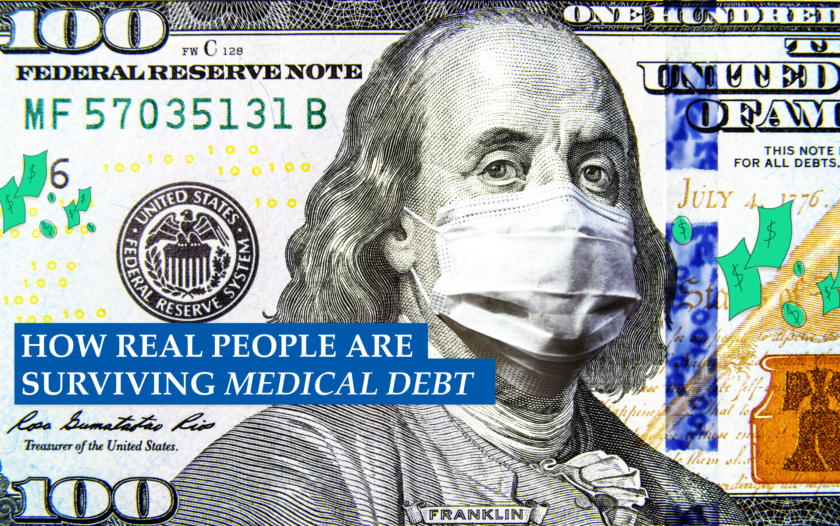How Real People Are Surviving Medical Debt
About Ashley
Ashley Jones is a freelance writer based in Houston, Texas and can be reached at ashleyaustin89@gmail.com. Her work has appeared across multiple platforms including Romper, Cancer Today, Publisher’s Weekly, Elite Daily, Mommy Poppins, Cancer Wellness Magazine, Motherfigure, Ladders News, and Let Grow.
Read full bio
Medical debt is a growing crisis, affecting countless families who find themselves overwhelmed by the soaring costs of healthcare. It’s a harsh reality that can leave families in a financial hole that, due to the rising cost of living, inflation, high interest rates, and more, is now harder than ever to climb out of. The components contributing to medical debt are complex, but there is no denying the detrimental impact it has on so many Americans.
A closer look at U.S. medical debt
More than 100 million Americans — an astounding 41% of adults — experience medical debt. In fact, medical debt is the most common form of debt on consumer credit records, according to a 2022 report from the United States Consumer Financial Protection Bureau, with $88 billion in consumer medical debt reported by U.S. credit bureaus as of June 2021. Since not all medical debts are reported to credit bureaus, however, the actual dollar amount is likely higher.
When you break them down, the facts and figures surrounding U.S. medical debt are mind-boggling. A joint report by National Public Radio (NPR) and KFF Health News (KHN), a nonprofit health reporting organization, relied on a nationwide poll conducted by the Kaiser Family Foundation (KFF) to give insight into the ongoing medical debt crisis. Below are key figures:
- In the past five years, more than half of U.S. adults have experienced debt because of medical or dental bills.
- 25% of adults with healthcare debt owe more than $5,000.
- About one in five people with healthcare debt say that they do not expect to ever pay it off.
- About two-thirds of people surveyed say they have postponed necessary care due to cost concerns.
- One in 10 individuals reports owing money to friends or family who covered their medical bills.
- 63% of Americans with medical debt say they have cut spending on food, clothing, and other necessities in order to manage their debt.
- Approximately one in six adults are in credit card debt due to paying medical or dental bills with their cards.
- Approximately one in seven people with medical debt report that they have been denied access to healthcare providers due to unpaid bills.
Even with the Affordable Care Act (ACA), which aimed to improve healthcare access and health insurance coverage, many Americans still struggle to afford medical treatment due to high premiums and other out-of-pocket expenses. Despite the ACA’s positive impact, there are still significant gaps in healthcare coverage, and it’s up to individuals to make up the difference with money straight out of their own pockets.
The rising costs of medical care have only served to exacerbate the medical debt crisis. Hospitals, drugmakers, and other healthcare providers have steadily increased prices, putting a significant strain on patients’ wallets. From 2012 to 2016, prices for medical care rose by 16%, nearly four times the rate of overall inflation, according to a report from the nonprofit Health Care Cost Institute.
While the numbers are shocking, the real stories of how medical debt impacts Americans and what they are doing to cope with the costs are even more eye-opening.
The detrimental impact of medical debt
Medical debt can have dire consequences for individuals and their families, forcing them to make unimaginable choices, such as choosing between putting food on the table and accessing the medical care they desperately need. As a result, many Americans are hesitant to seek care when they need it, creating a cyclical impact where the sick get sicker and the financial strain caused by medical bills slows recovery and may even increase a patient’s likelihood of survival, according to clinical researchers interviewed for the NPR-KHN report.
The same report also showed how medical debt in the U.S. exhibits significant disparities depending on individual factors like race, location, age, and health history. Demographically, Black adults are 50% more likely and Hispanic adults are 35% more likely than their Caucasian counterparts to carry medical debt, underscoring the disproportionate burden of medical bills on communities of color. Geographically, medical debt is most prevalent in southern states, while age-wise, medical debt is nearly twice as common among adults under 30 compared to those 65 and older. Even Medicare coverage does not shield seniors from accruing thousands of dollars in medical charges. The impact of chronic diseases is also quite evident, as U.S. counties with the highest rates of chronic illnesses have medical debt levels reported to be three to four times higher than the healthiest counties.
While proper financial planning and savings can help individuals cover unexpected medical expenses, and having an emergency fund can provide a financial safety net, those funds will only go so far in the event of unexpected medical debt — especially when the amount is high.
Some people turn to loans to cover medical expenses, but this approach can lead to high interest rates and increased financial strain. However, if you took out multiple loans to pay off medical debt or have other debt in addition to emergency loans, it may be worth considering consolidating your loans to pay down your debt faster.
Find and compare the best loan options.
Use the filters below to refine your search

Sorry, we didn’t find any options that meet your requirements. Please try modifying your preferences.
Congratulations! You’re close to seeing your offers!
Please take a second to review the details you shared earlier
Sorry, we didn’t find any options that meet your requirements. Please try modifying your preferences.
How are Americans surviving medical debt?
To survive the impact of medical debt, many Americans are forced to borrow money from family and friends, take out loans, go into credit card debt, or find alternative solutions to get through the experience. Here’s a look at how real people are doing it:
1. Crowdfunding: Former U.S. Olympic gymnast Mary Lou Retton’s recent situation is a stark example of how many are resorting to crowdfunding to cover their medical bills. After a recent hospitalization, the Olympian’s family turned to the public for help covering costs, as she does not have health insurance. Unfortunately, this trend is not limited to celebrities. According to reporting from The New York Times, every year, a quarter of a million Americans turn to crowdfunding campaigns to pay for their medical expenses, but most never meet their goals, and up to 16% receive no funds at all.
2. Negotiation & payment arrangements: After a car accident, Kimberly Wall faced unexpected medical expenses that put her in debt. “Coping with the emotional and financial toll, I turned to my family, friends, and congregation for support and researched resources to ease the stress,” she tells Credello. During the course of her research, Wall discovered community organizations designed to assist people in her exact situation.
“One of the key resources I found helpful was a local non-profit organization that provided financial counseling and assistance to people facing medical debt. They helped me understand my options and even negotiated with the hospital on my behalf to work out a more manageable payment plan. This made a significant difference in easing the financial burden,” she explains. “In addition to that, I also sought guidance from hospital billing professionals. They were surprisingly understanding and willing to work with me to set up a payment arrangement that aligned with my financial situation. It’s essential to communicate openly with healthcare providers because, in my experience, they can be quite accommodating when they know your circumstances.”
3. Support from family & friends: Wall, who is the co-founder of BibleKeeper, says that another resource she turned to for help with medical debt was her faith community. “They not only offered emotional support but also organized fundraising events to help with my medical expenses. The power of community and faith cannot be underestimated in times of crisis,” she says. With one in 10 people reporting that they borrowed money from family or friends to pay medical bills, Wall’s experience of relying on her community is anything but uncommon.
4. Medical credit cards: These cards are often marketed through doctors’ offices and hospitals to patients as a solution for paying off medical debt, but they can come with deferred interest rates that may lead to higher costs if payments are missed and potentially drive up the cost of healthcare services. There is also concern that they lack consumer protections which limit how healthcare debt can affect credit scores, according to a report by nonprofit Public Interest Research Groups (PIRG).
In one instance, a North Carolina woman facing a $28,000 bill for cancer treatment used a medical credit card to pay partial payments toward her expenses. She still owed almost the entire amount after paying for six years and was sued by the hospital for the balance, according to Consumer Reports.
Bottom line
For Wall — and others like her who have paid off their medical debt — surviving medical debt was possible through the support of others. “It’s crucial to explore all available resources and to reach out to both formal organizations and your support network when facing medical debt,” she says. “Every little bit of assistance and understanding can make a significant difference on the path to overcoming such challenges.”
The medical debt crisis in the United States is a complex issue with far-reaching consequences. No one should have to choose between their health and their financial well-being, but this is the unfortunate reality for so many Americans who face this monumental challenge.









